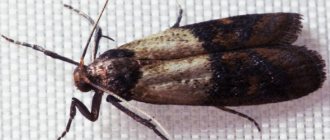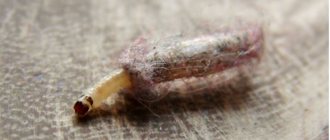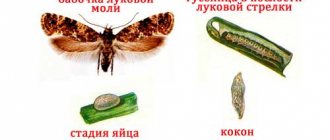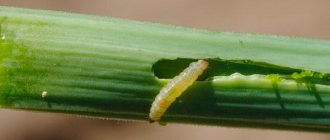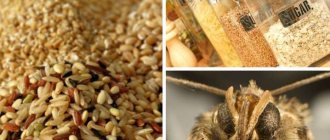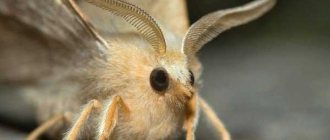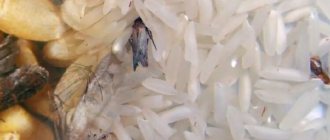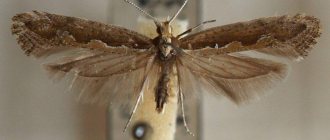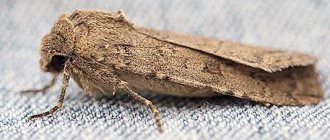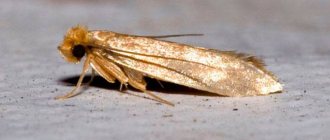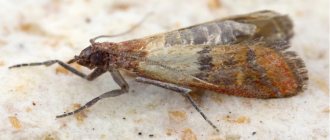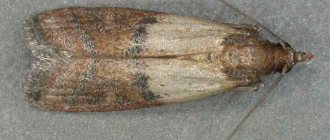What is food moth
A moth is a parasitic insect that feeds on various cereals, food mixtures, flour products, and also clothing. Depending on what moths feed on, they are divided into several varieties, which we will briefly consider.
The food moth is an individual that has wings whose dimensions reach up to 10 mm. Butterflies have no colors, so they have a gloomy appearance, which sometimes blends them in with the food where they live. Butterflies multiply quite quickly, which negatively affects the food supplies and clothing of household members, which they like to eat. The most common types of food moths are:
- Flour butterfly. This moth can be distinguished by the brownish color of its wings, which often blends in with flour products, making the insect invisible. But you just have to look closely to find moths in a package of flour products.
This is what a common food moth looks like, which can be found in our kitchen.
- Mill moth. This butterfly is found in rare cases, as it lives mainly in utility rooms where grain crops are stored. But occasionally, a butterfly can still be found in the kitchen in a bag with cereals such as corn, barley, wheat and barley. The moth has a significant difference: the upper part of the wings has a dark gray tint, and the lower part is white.
- Cocoa moth. Despite the name, the cocoa moth feeds on various types of cereals, and you can meet it much more often than the preliminary representative. This moth has a lightish tint to its wings, so it blends in well with food.
- Barn moth. This type of moth has a bright shade of wings, so it is almost impossible to confuse it with other species. This type of insect is very difficult to remove.
Despite the significant differences between different types of food butterflies, their larvae are practically indistinguishable from each other. The larvae hatch into caterpillars, which often have dimensions not exceeding 1.5-2 cm. Butterflies lay larvae directly in their habitats, so after the caterpillars are born, they begin active feeding. After a short time, an adult emerges from the caterpillar, which is ready for further reproduction.
The secret to efficiency
A common pest in the kitchen is food moths. The butterfly enters the room through open windows, larvae, eggs - along with fruits, products, backfill from the store. The butterfly itself is not dangerous for a person and his home. She doesn't eat anything, she doesn't spoil anything. But, once in the house, she looks for a favorable place to lay eggs. It should be dry, dark, and have plenty of food.
The moth lives for about 2 weeks, during which time the butterfly lays about a hundred eggs. After a few days, larvae appear - small, voracious caterpillars. Gradually they are populated in almost all food supplies in the kitchen. Moth larvae feed on food and practically do not leave hot spots; only when they are heavily infested, they travel around the apartment. After 1-2 months they pupate and moths appear.
On a note!
To find a suitable place for larvae with an abundance of food, butterflies are guided by their sense of smell. Smells connect the insect with the outside world. Persistent strong aromas prevent the female from finding her way around the area and finding a place to lay eggs. In such a situation, the moth either flies away through open windows or dies without leaving any offspring.
Features of moth breeding
As soon as a foreign object is detected in food, it is immediately necessary to take measures to combat it. There are many special tools and preparations for this. These funds can be divided into two categories:
- Preparations that allow you to destroy the food moth.
- Preparations that are designed to repel domestic butterflies.
The most effective option is to exterminate moths, but after disinfestation there is no guarantee that these insects will reappear. What is better to choose to get rid of food moths once and for all? First, let's look at the means by which you can exterminate moths from an apartment.
Preventive measures
When replenishing your food supply, it is important to remember some preventive measures:
- Be careful when purchasing groceries at low prices, checking the expiration date and condition of the packaging.
- Before storing, treat with cold or high temperature.
- Store all products in airtight containers.
- Use moth repellents.
- Do not stock up on large amounts of food.
- Monitor the condition of kitchen cabinets, wash and ventilate them regularly.
- Conduct an inspection of existing inventory.
Following preventative practices will help preserve food.
How to kill moths: insecticides and fumigators
To understand how you can destroy a butterfly, you need to find out what it is afraid of. And this parasite is afraid of various pungent odors, temperature fluctuations, as well as other natural substances and chemical insecticides.
10 effective methods on how to permanently get rid of moths in an apartment
The main means by which moths, larvae and caterpillars can be destroyed include various types of insecticides and fumigators. These are modern drugs that are designed to kill insects living in food products. Such drugs are absolutely safe for humans, so they can be used without fear.
Before purchasing and using an insecticide, it is necessary to clarify whether this product is truly safe for humans.
Insecticides for killing moths are available in the form of sprays and aerosols, which makes their use much easier. Spraying of such preparations is possible only on various objects, clothing, etc., but only with the exception of food products. But since moths often live in food products, the effectiveness of aerosols and sprays is very low. You can use an aerosol by spraying it on cereals, but only after this the product will need to be disposed of.
Special fumigators are most popular for killing kitchen moths. These are special devices that, when heated, emit insecticide-containing substances. Fumigators are often powered by electricity, which results in heating. The smell gradually spreads, killing parasites that fall into the fumigator's area of effect. The disadvantage of this remedy is the short duration of action of the drug. It may take several weeks for the smell to reach the food pest. You can purchase such fumigators at any specialized store, but you should not expect high efficiency from such devices.
Additional Tips
For many years, naphthalene, which has a specific odor, was used to repel moths. Today, its use is not recommended, since in addition to the unpleasant aroma, the substance accumulates in the human body and has harmful carcinogenic properties.
Moth repellent grass and other harmless natural substances that have a pleasant smell work more effectively in tandem with each other. With their help, interesting mixtures are combined that repel insects while filling living spaces with fragrance.
Clothes moth larvae feed not only on natural, but also synthetic materials. When laying out repellents or using chemical insecticides, artificial food sources for the pest are also treated. Over time, the moth develops immunity to most folk recipes, so a periodic change of natural remedies is recommended.
Insect larvae do not take root well in low humidity conditions and in bright light. It is advisable to keep the locations of clothing and groceries dry and clean. After purchase, not new fur products must be aired in the cold or dry cleaned.
To avoid encountering harmful moths at home, it is advisable to use one of the many folk remedies to repel them. When moths are found, which are likely to provoke the appearance of larvae, natural substances become ineffective. In this case, you cannot avoid purchasing chemical insecticides, giving preference to drugs that are effective but harmless to human health.
Is the moth afraid of the cold?
What else are moths and their larvae afraid of, besides insecticides and fumigators, the use of which does not reach the required level? Food butterflies are quite sensitive to temperature changes, so any temperature fluctuations can serve as an option for killing insects. Moths are afraid of the cold, so to kill them, you can simply place the jar or bag of cereal where the insect lives on the balcony.
The death of the insect occurs when the temperature drops to minus 2 degrees. The larvae are much more stable, so you will need to wait until the temperature drops to -10 degrees.
Even if you find parasites in the summer, you can always use the temperature method of killing moths. To do this, place the container where the cereal is stored along with the butterflies in the freezer. You can get the container out after a few hours, when the insects freeze out.
An exhaustive answer was received to the question of whether moths are afraid of the cold. But what about high temperatures? At the upper limit, the death of food butterflies occurs with an increase in temperature above 40 degrees. It is impossible to increase the air temperature to such limits, so the best option is to scald the insect with boiling water. But in this case, you will need to either remove the moth from the container with food, or pour it directly there.
If moths live in clothes, furniture or other objects, then it is enough to take them outside to freeze the insect. Many people do this when they find moths in their apartment. They simply take all their clothes out onto the balcony for a day, resulting in the destruction of insects.
Having considered the main methods of destroying food moths, it remains to find out what can be used to repel the moths in order to avoid unpleasant consequences. The modern industry, which produces special aromatic preparations, will help us understand this issue.
Tips to help fight moths:
List of basic moth repellents
Scientists have long discovered what odors moths are afraid of, on the basis of which a whole arsenal of various drugs has been developed. Such preparations include technical means, essential oils, fragrant plants, and fruits.
The effectiveness of these tools depends on the desired result. The use of aromatic oils allows not only to fight moths everywhere, but also to create a certain harmony in the apartment. Dried herbs have a very strong smell, which may be effective, but not every person can live with such a fragrance. Let's take a closer look at what is best to use to repel moths.
Essential oils
Because manufacturers supply so many extracts, it is difficult for consumers to determine which essential oil is best to use. The following compositions are considered the most popular:
- Lavender. Their aroma is not tolerated by larvae, pupae and gray butterflies. Such extracts are used in the preparation of gel and standard sections, covers for fur coats and other fur clothing. Such containers are installed everywhere, achieving acceptable results.
- Patchouli. Drops of this oil are added to warm water, which is used during wet cleaning. The solution is suitable for cleaning floors, cabinets and window openings. It is allowed to treat ventilation shafts through which pests enter the house.
- Orange or lemon. These extracts are distinguished by an increased concentration of substances and flavors. Therefore, they are suitable for destroying clutches and controlling larvae at home.
- Conifers. When figuring out what kind of oil the clothing species are afraid of, you should take a closer look at pine extracts. In this case, you can use not only essential oils, but also individual parts of pine tree resin.
- Mints. They are suitable for completing cabinets and wardrobes. A dried plant is also suitable for these purposes. But the duration of its operation is short, so it is periodically replaced.
The demand for extracts and essential oils is due to the fact that they give off a rich and lasting aroma. The aroma of perfume has similar properties. Therefore, perfumes are used to repel moths and other pests.
Special sections and butterfly tablets
Sections are special means that are saturated with solutions that are unacceptable for moths. Such sections are also called “smells”, which are hung in the closet or glued to the door. These drugs are good because in addition to repelling insects, they prevent the emergence of new pests. They are used as both the main means of repelling insects and for preventive purposes, especially if an expensive fur coat is stored in the closet. Read more in this article for 5 proven remedies on how to remove moths from a fur coat.
“Scents” have a short lifespan, so to prevent the appearance of moths, it is necessary to change them every 1 month. Today, modernized versions of repellers are known that can serve for a year.
To remove food moths, you need to place sections in the kitchen in cabinets near the cereal storage.
In addition to sections, you can also use dry perfumes against pests, which come in the form of small bags filled with herbs. Often such herbs have a pleasant smell for humans, but repel moths. In addition to dry grass, the bags can be filled with special flavored balls.
Another effective industrial product for repelling food butterflies is a special tablet. Such a tablet is placed in those places where there are signs of the existence of moths, after which its action begins. It begins to emit a smell that forces butterflies to leave their usual habitats. The duration of action of one tablet is six months, so you can forget about the problem for a long time.
Lifespan
Life cycle of a moth.
After mating, kitchen moths look for a moist, warm place where they will lay eggs. She needs 5-7 hours for fertilization and laying, after which she dies.
It takes 5-7 days from the maturation of the eggs to the appearance of the larvae. At one time, the female lays 50-100 eggs; they are very small, and it is almost impossible to notice their presence on food.
After emergence, the larva begins to eat food and throw waste into it. Cocoon formation is the final stage when cobwebs or balls appear in products.
The life cycle from egg to mating adult lasts 6-8 weeks.
